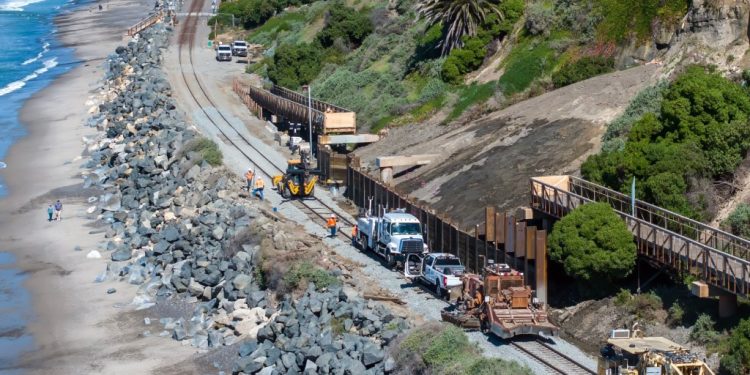Public transport officials said this week that they planned to add more sand and rock along the beach in San Clemente, where the landslides suspended the passenger train service in San Diego for months in recent years.
The Orange County Transportation Authority submitted a coastal emergency development permit on Monday to California Coastal Commission to accelerate work on four projects, including repairs to Mariposa Point, where a slow slide triggered by seasonal rains stopped the passenger service for more than three months at the start of 2024.
“There has been a series of new landslides near Mariposa Point in the past year (and) although they had no impact on rail service, the debris of these slides are heading for the track,” said Joel Zlotnik, director of strategic communications for Octa, in an email on Tuesday.
“These landslides clearly indicate that it continues to be active hill movements and unstable slopes above the railway line in several places,” said Zlotnik. “An additional movement on the hillside has occurred as recently as February.”
Debris and mud approach the top of the temporary watershed wall 12 feet high built a year ago, agency officials said.
In addition to reconstructing the beach sand and strengthening the coating, Octa plans to build a permanent watershed wall and restore the section of a popular pedestrian coastal track destroyed by the landslide.
The agency’s board of directors at its meeting on April 14 should authorize the director general to conclude agreements with entrepreneurs to do the work.
Suzie Whitelaw, president of the group of San Clemente Save Our Beaches, said that more sand was still good. But it was skeptical about the use of rock and if the public transport agency can obtain the necessary permits to complete the work in less than two years.
Rocky coatings, dikes and other hard structures built on the beach limit public access and can contribute to coastal erosion. Instead, environmentalists and groups such as save our beaches prefer to use only sand.
“We support all octa effort to place sand instead of rock on our beaches,” said Whitelaw. “However, I fear that it is more a signal of public relations than a real project. It is not actually a request. There is no auction package. “
The executive director of California Coastal Commission Kate Huckelbridge, in a letter of February 25 at the Octa, said that the Commission will work with the Orange County agency, but questioned the need for an emergency permit.
A regular coastal development permit, which could prolong the process, would allow a better examination of all options, including the use of less rocky coating, she said.
“Our agency wants to see sand on these beaches as soon as possible,” said Huckelbridge. “We understand the importance of this train corridor for the region and share a deep sense of urgency to keep the corridor functional.
“We also understand the value of the region’s beaches for residents and visitors as well as the importance of maintaining public access in the middle of the rapid loss of the beach in front of parts of the track,” she said. “We believe that sand food can be an effective strategy, regardless of or in combination with other protective measures, both to protect the railway corridor and maintain public access to the beach, at least in the short and mid-term period.”
The Octa estimates that 5,100 cubic yards of Riprap and 240,000 cubic yards of sand will be necessary to protect Mariposa Point in addition to the work carried out last year.
At the southern end of the project, near San Clemente State Beach, 1,400 Cubic Riprap repair yards, 22,000 cubic cubes of engineering, dike or functionally equivalent structure, and 300,000 cubic yards of sand are necessary to protect the track.
OCTA received more than $ 300 million in state and federal funding last year for work.
The various elements of the coastal stabilization projects will occur “on different deadlines depending on their complexity and their availability of entrepreneurs and their equipment,” said the agency’s announcement. The specific or approximate start and end dates have not been announced, although this highlighted the need for rapid work.
“Emergency measures are necessary to prevent additional disturbance in the vital rail service,” said OCTA officials. “In addition, continuous erosion requires rapid action to repair and replace the existing Riprap, and deliver enough sand to help protect the tracks.”
The rail service between San Clemente and San Diego has not been available for a year more than a year since a hill has slipped under the slopes of the Cypress Shore community just north of the San Onofre state beach in 2021.
The freight trains continued during most of the closures, generally traveling slowly at night when no repair work was in progress.
Originally published:
California Daily Newspapers


